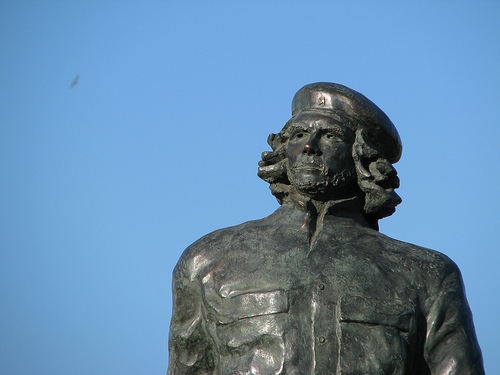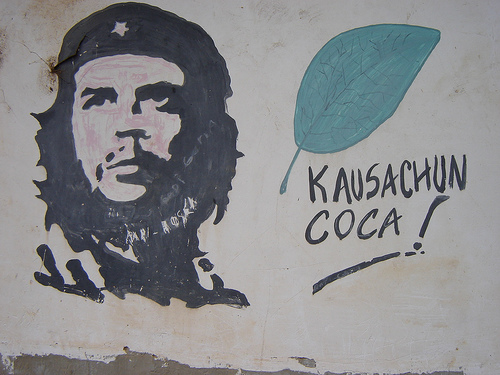
Ernesto ‘Che’ Guevera and his final days in Bolivia
10 February, 2011Ernesto Guevara de la Serna lost his life on the 9th of October 1967 at the hands of the Bolivian Army and the CIA in La Higuera, a very little village in the heart of Bolivia, where he was leading a guerrillas force towards the liberation of the Bolivian people and the democratization of the country. A man who had embraced the spirit of South America would become a symbol of the fight of the continent to regain their autonomy from bigger nations which had kidnapped their resources. But what took the masses to conceive ‘El Che’ as a martyr rather than a killer? It’s best to let his story do the talking.
Guevara was born in Rosario, Argentina, in 1928, to an aristocratic family which enjoyed the privileges of money, culture and class and strictly adhered to the morals of the time. Known as ‘Che’ after the distinctive Argentinian expression, during his thirty-nine years of life, although his country was never among the ones he had to fight for.

Guevara studied medicine at the University of Buenos Aires, where he lived for five years until he left for his first trip across South America at the beginning of 1952 with friend Alberto Granado. Together, they visited Chile, Peru, Colombia and Venezuela. The impact of the poverty and deprivation he saw had a lasting effect. At some point between his travels and leaving university ‘Che Guevara’ was born.
After travelling through-out South and Central America he tried to work as a doctor in Guatemala, to eventually arrive in Mexico, where his political views were defined and reinforced by the social climate. That time would be key: young Che joined the 26th of July Movement, a revolutionary group which aimed to topple Batista from the Cuban government. This was led by Fidel Castro, a young lawyer from Havana who already had a reputation for being a smart and brave political activist. Hence, the Cuban Revolution, the subsequent victory on New Year’s Day 1959 and their rise to power.
But what makes him different from other revolutionaries? What makes him remain as a universal icon instead of another fraud who softened the minute he smelled power? Who was the real Che Guevara? A man of principle, a man of reason, a man of goodness. He believed that South America needed to be its own governor, not be constrained by stronger political forces. After holding different positions within the new Cuban government, he left to go with revolutionary groups sent from Havana to contribute where action was needed to liberate oppressed peoples. First Congo in Africa, then a time of isolation in the Czech Republic. And eventually, in 1966 Bolivia came along.
Castro and Guevara decided to establish a revolutionary base in Bolivia: due to its strategic position in the South American continent, it would be easy to spread the revolutionary war to adjacent nations. In Bolivia, however, they had to fight against a military dictatorship which had replaced the elected president in 1952 ending with the country’s hope of social improvement and democracy. Che secretly arrived in La Paz in November 1966 and started writing his diaries straight-away; the diaries, which collect emotions and ideas throughout all his trips and missions, would prove to be the greatest record of his life, showing the greatness and talent of this controversial character. In 1998, Jaime Niño de Guzmán, pilot of the helicopter used in the anti-guerrillas operation which would end with Guevara’s death, gave the Bolivian Times the notepad that Che carried with him when he was captured: a draft of a project describing ideas for the liberation of South America was contained in its pages. The document explains in the words of Che Guevara his desire for a better South America, the faith he had in the cause he was fighting for, and a call for all workers, peasants and citizens of Bolivia who wanted to live in a regime, free of restrictions and exploitation, together with those citizens and authorities from other countries whose support was needed to progress in the liberation of the continent.
He knew that in order for Bolivia to confront those who were benefiting from its resources and peoples, citizens had to be educated, democracy had to operate on the basis that everyone’s voice had a place, both society and communications had to develop between the different communities and ethnicities, and workers from all sectors had to be actively involved in the fight. All of this required a detailed plan to follow. These notes date from the time before March 1967, when he named his group Bolivia’s National Liberation Army; three months ahead of the San Juan massacre organised by Rene Barrientos’ government in the Bolivian villages where the miners had planned to ‘associate’ with Che Guevara’s guerrillas. Dozens of people were killed or injured; the political tensions grew in the country and made Guevara’s search and capture more of a priority than ever. Although it cannot be said to what extent the CIA were involved in the actual murder, it is a fact that Felix Rodriguez, an American agent, was one of the protagonists of Guevara’s death, and the last one to take a picture of Ernesto alive.

On the 9th of October 1967, the legend says that his body was exhibited in a washing place in Vallegrande, his eyes wide open, a haunting gesture intended to demonstrate the movements continuing life, even after a key protagonist’s death. His beliefs turned him into a symbol of a common cause in South America, to fight for a common ideal. His power was not only political or military, it was philosophical, and he followed the ideas exposed in his notes until they led him to death in cold blood. In a tribute, the Hispanic world keeps singing We learnt to love you, from the heights of history, when the sun of your bravery, laid siege to death. And so remains a beloved South American character, for those who love South America, commander Che Guevara.
Buy Che Guevara’s Bolivian Diary to find out more about his final days.
Follow Sounds and Colours: Facebook / Twitter / Instagram / Mixcloud / Soundcloud / Bandcamp
Subscribe to the Sounds and Colours Newsletter for regular updates, news and competitions bringing the best of Latin American culture direct to your Inbox.

